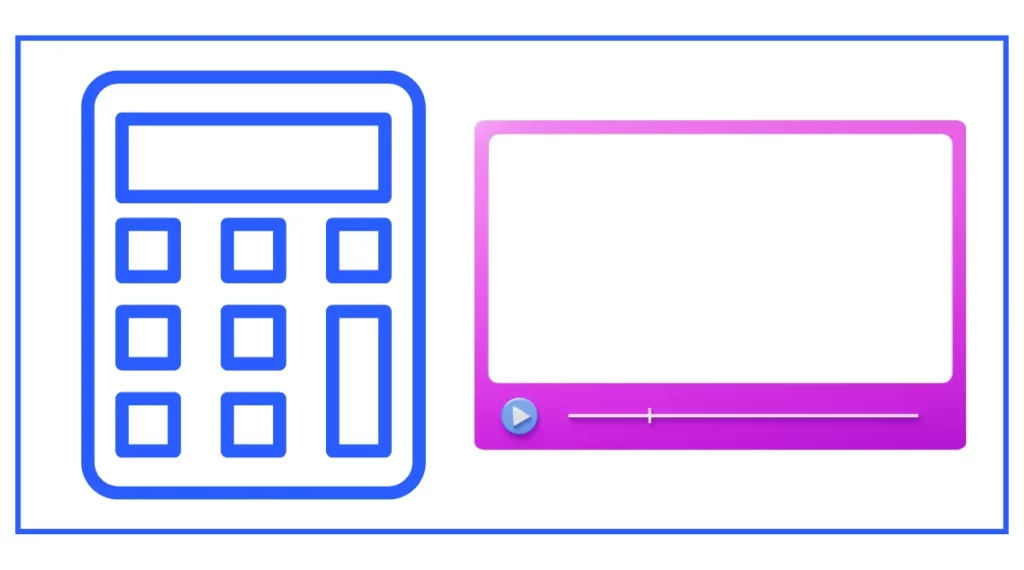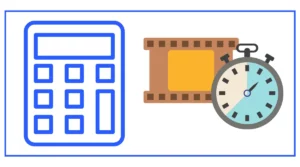Timecode to Frames Calculator
Are you a video editor?
Do you want to find out how the number of frames depends on the frame rate?
This Timecode to frame calculator allows you to calculate the total frames by just entering the frame rate and timecodes in hours, minutes, and seconds.

You can also easily find the timecode and video space by entering the frames.
What is a Timecode?
A timecode is a sequence of numeric codes generated at regular intervals by a timing system. It’s used in video production, filmmaking, and other multimedia applications to provide a precise time reference for each frame of video. Timecodes are typically displayed in the format of hours:minutes:seconds:frames (HH:MM:SS:FF).
Understanding Frame Rates
Before diving into the calculator’s functionality, it’s essential to understand frame rates. The frame rate, measured in frames per second (fps), is the number of individual images (frames) displayed in one second of video. Common frame rates include:
- 24 fps: Standard for film
- 25 fps: Used in PAL video systems
- 29.97 fps: Common in NTSC video systems
- 30 fps: Used in some high-definition video formats
- 60 fps: Often used for slow-motion footage or gaming content
How the Timecode to Frames Calculator Works
Our timecode calculator converts the timecode into a total number of frames based on the specified frame rate. Here’s a step-by-step breakdown of how it operates:
- Input the frame rate of your video.
- Enter the timecode in hours, minutes, seconds, and frames.
- Click the “Calculate” button.
- The calculator will display the total number of frames.
Using the Timecode Calculator
To use the calculator effectively, follow these guidelines:
- Frame Rate Selection: Choose the appropriate frame rate for your video project. This is crucial for accurate conversion.
- Timecode Input: Enter the timecode values in their respective fields:
- Hours: 0-23
- Minutes: 0-59
- Seconds: 0-59
- Frames: 0 to (frame rate – 1)
- Calculation: After inputting the values, click the “Calculate” button to get the total frame count.
- Result Interpretation: The “Total Frames” field will display the calculated number of frames.
Practical Applications of the Timecode to Frames Calculator
Video Editing
Video editors frequently need to convert timecodes to frame numbers. This calculator simplifies the process, allowing editors to quickly determine the exact frame for a specific edit point.
Example: An editor working on a 24 fps project needs to make a cut at 00:01:30:12 (1 minute, 30 seconds, and 12 frames). Using the calculator, they can determine that this timecode corresponds to frame number 2,172.
Animation and Visual Effects
Animators and VFX artists often work with specific frame numbers rather than timecodes. This calculator helps them convert director’s notes or edit decisions from timecode to the exact frame they need to work on.
Film Production
During film production, the timecode calculator can help synchronize different elements like audio and video, ensuring that everything aligns perfectly in post-production.
Quality Control
QC teams can use the calculator to pinpoint exact frames where issues occur, making it easier to communicate problems and solutions with the editing team.
Advanced Features and Considerations
Drop Frame vs. Non-Drop Frame Timecodes
It’s important to note that this calculator assumes a non-drop frame timecode. Drop frame timecode is a method used in NTSC video to account for the difference between the nominal frame rate (30 fps) and the actual frame rate (29.97 fps). For accurate calculations with drop frame timecodes, additional adjustments would be needed.
Handling Different Frame Rates
The calculator allows you to input various frame rates, making it versatile for different video formats. Always ensure you’re using the correct frame rate for your project to get accurate results.
Reverse Calculation: Frames to Timecode
While this calculator converts timecode to frames, you might sometimes need to do the reverse. To convert frames back to timecode:
- Divide the total frames by the frame rate to get the total seconds.
- Convert the total seconds to hours, minutes, and seconds.
- The remainder after the decimal point, multiplied by the frame rate, gives you the frames.
Common Scenarios and Examples
Let’s explore some common scenarios where the timecode to frames calculator proves particularly useful:
Scenario 1: Finding a Specific Frame in a Long Video
Imagine you’re editing a 2-hour documentary shot at 24 fps, and you need to locate a specific moment at 01:45:23:18.
Using the calculator:
- Frame rate: 24
- Hours: 1
- Minutes: 45
- Seconds: 23
- Frames: 18
The calculator would show that this timecode corresponds to frame number 152,682.
Scenario 2: Determining Edit Points for Slow Motion
You’re working with footage shot at 60 fps for a slow-motion sequence, but your final video will be 24 fps. You want to find the frame range for a 5-second clip starting at 00:03:45:00.
First calculation (start point):
- Frame rate: 60
- Hours: 0
- Minutes: 3
- Seconds: 45
- Frames: 0
Result: Frame 13,500
Second calculation (end point, 5 seconds later):
- Frame rate: 60
- Hours: 0
- Minutes: 3
- Seconds: 50
- Frames: 0
Result: Frame 13,800
This tells you that your slow-motion clip will use frames 13,500 to 13,800 from the original footage.
Tips for Efficient Use of the Timecode Calculator
- Verify Frame Rate: Always double-check that you’re using the correct frame rate for your project.
- Use for Batch Calculations: If you need to convert multiple timecodes, consider doing them in batches to save time.
- Cross-Reference: When precision is critical, it’s a good practice to cross-reference the calculator’s results with your video editing software’s frame count.
- Understand Limitations: Remember that this calculator doesn’t account for drop frame timecode. For projects using drop frame, additional calculations may be necessary.
- Practice with Different Scenarios: Familiarize yourself with various timecode and frame rate combinations to become more efficient in your workflow.
Conclusion
The timecode to frames calculator is an essential tool for anyone working in video production, editing, or related fields. By simplifying the conversion process, it allows professionals to focus on their creative work rather than getting bogged down in manual calculations. Whether you’re precise
ly timing cuts, synchronizing audio and video, or communicating specific moments in a video, this calculator streamlines your workflow and enhances accuracy.
Remember that while this tool is incredibly useful, it’s always important to understand the underlying concepts of timecodes and frame rates. This knowledge, combined with the calculator, will make you more efficient and effective in your video-related projects.
As you continue to work with various video formats and frame rates, you’ll find that this timecode calculator becomes an indispensable part of your toolkit. It bridges the gap between different ways of measuring video time, allowing for seamless communication and precision across all stages of video production and post-production.





